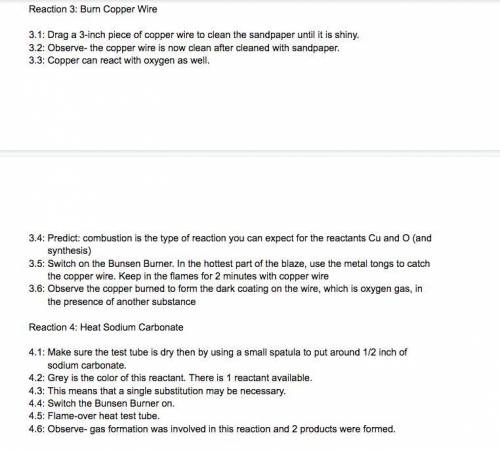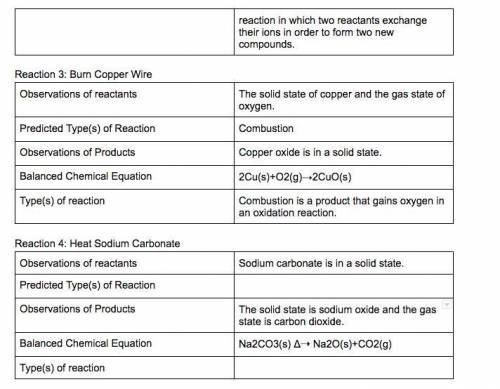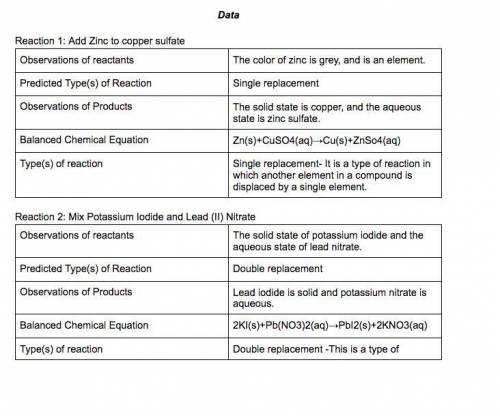Lab: Types of Chemical Reactions
Student Guide
This laboratory allows you to study various ki...

Lab: Types of Chemical Reactions
Student Guide
This laboratory allows you to study various kinds of chemical reactions, including some that result in precipitates.
Lesson Objectives
• Compare and contrast synthesis, single-displacement, and double-displacement reactions.
PREPARE
Approximate lesson time is 60 minutes.
Materials
• Lab Instructions: Lab_5.08_Instructions_modified_2020
• Lab Report: Lab_5.08_Report_modified_2020
• Lab Guidelines: Lab_Guidelines_modified
LEARN
Activity 1: Types of Chemical Reactions 1
Instructions
As you read through the lesson online, use the space below to take notes.
In this laboratory, you will study different kinds of chemical reactions.
Knowing the types of reactions helps you interpret your observations.
In a synthesis reaction, two reactants unite to form a third product.
In a single-displacement reaction, one ion of a reactant bonds with the second reactant.
In a double-displacement reaction, ions of both reactants change places.
Activity 2: Types of Chemical Reactions 1
Instructions
Procedure
1. Open the Chemical Reactions Virtual Lab.
2. Click View the Tutorial and complete the tutorial to learn how to conduct the lab.
3. Close the tutorial and click begin the Lab.
Part 1 Synthesis Reaction
4. Perform the procedure, placing the magnesium strip in the flame.
5. Record your reaction.
6. Research the chemical reaction of magnesium and oxygen gas. Write an equation for the chemical reaction
that accounts for the observed reaction in this part of the lab.
7. Answer the question: What is a synthesis reaction?
8. Answer the questions on Part 1 in the Lab Report.
Part 2 Single Displacement Reaction
9. Place 1 scoop of zinc in Vial A and add 10 drops of copper (II) sulfate. Observe the reaction.
10. Place ball of aluminum in Vial B and add 10 drops of copper (II) sulfate. Observe the reaction.
11. Place 1 scoop of zinc in Vial C and add 10 drops of silver nitrate. Observe the reaction.
12. Place copper wire in Vial D and add 10 drops of silver nitrate, wait 5 minutes. Observe the reaction.
13. Complete the ta

Answers: 1
Other questions on the subject: Chemistry

Chemistry, 21.06.2019 21:00, yousifgorgees101
The earth's moon is unusually large. two popular theories of the moon's origin include the "sister world" hypothesis, which states that the moon formed from the same materials as the earth, near enough to the earth that they fell into orbit around each other. a second theory is the "capture" hypothesis, in which the moon formed elsewhere in the solar system, and the earth's gravity pulled it into its orbit. studies of what the moon is made of indicate that some of its materials had to come from the earth or from the same area of the solar system where the earth had formed. at the same time, the moon does not contain much of the material that makes up the earth's core, so the moon could not have formed from the same materials as the earth. how do the two facts above affect the described theories of the moon's origin? a. they show that scientists will never agree on where the moon came from. b. they show that more experiments on moon formation need to be done. c. they show that no theory accounts for the existence of the moon. d. they show that neither theory is complete and entirely correct.
Answers: 1

Chemistry, 22.06.2019 03:50, daniel9299
Consider the reaction: n2(g) + o2(g) ? 2no(g) kc = 0.10 at 2000oc starting with initial concentrations of 0.040 mol/l of n2 and 0.040 mol/l of o2, calculate the equilibrium concentration of no in mol/l how would this be done?
Answers: 3

Do you know the correct answer?
Questions in other subjects:

Mathematics, 26.03.2021 20:50

Biology, 26.03.2021 20:50




Engineering, 26.03.2021 20:50

Mathematics, 26.03.2021 20:50

Mathematics, 26.03.2021 20:50

Mathematics, 26.03.2021 20:50

Mathematics, 26.03.2021 20:50










